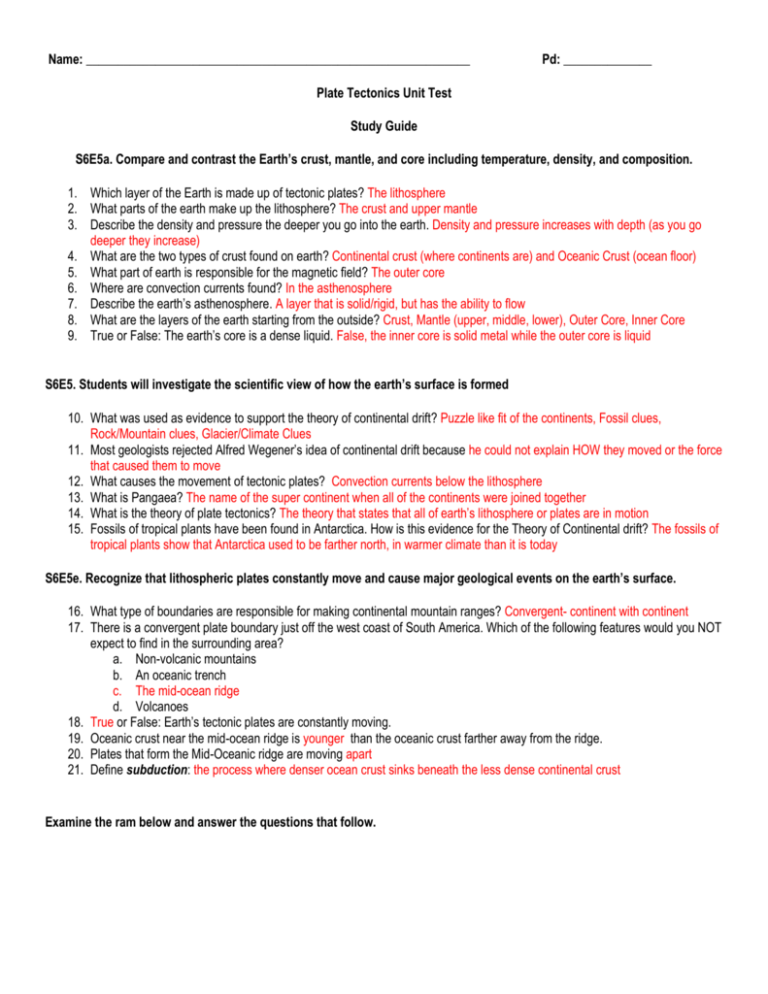Name: Pd: Plate Tectonics Unit Test Study Guide S6E5a. Compare
advertisement

Name: _____________________________________________________________ Pd: ______________ Plate Tectonics Unit Test Study Guide S6E5a. Compare and contrast the Earth’s crust, mantle, and core including temperature, density, and composition. 1. Which layer of the Earth is made up of tectonic plates? The lithosphere 2. What parts of the earth make up the lithosphere? The crust and upper mantle 3. Describe the density and pressure the deeper you go into the earth. Density and pressure increases with depth (as you go deeper they increase) 4. What are the two types of crust found on earth? Continental crust (where continents are) and Oceanic Crust (ocean floor) 5. What part of earth is responsible for the magnetic field? The outer core 6. Where are convection currents found? In the asthenosphere 7. Describe the earth’s asthenosphere. A layer that is solid/rigid, but has the ability to flow 8. What are the layers of the earth starting from the outside? Crust, Mantle (upper, middle, lower), Outer Core, Inner Core 9. True or False: The earth’s core is a dense liquid. False, the inner core is solid metal while the outer core is liquid S6E5. Students will investigate the scientific view of how the earth’s surface is formed 10. What was used as evidence to support the theory of continental drift? Puzzle like fit of the continents, Fossil clues, Rock/Mountain clues, Glacier/Climate Clues 11. Most geologists rejected Alfred Wegener’s idea of continental drift because he could not explain HOW they moved or the force that caused them to move 12. What causes the movement of tectonic plates? Convection currents below the lithosphere 13. What is Pangaea? The name of the super continent when all of the continents were joined together 14. What is the theory of plate tectonics? The theory that states that all of earth’s lithosphere or plates are in motion 15. Fossils of tropical plants have been found in Antarctica. How is this evidence for the Theory of Continental drift? The fossils of tropical plants show that Antarctica used to be farther north, in warmer climate than it is today S6E5e. Recognize that lithospheric plates constantly move and cause major geological events on the earth’s surface. 16. What type of boundaries are responsible for making continental mountain ranges? Convergent- continent with continent 17. There is a convergent plate boundary just off the west coast of South America. Which of the following features would you NOT expect to find in the surrounding area? a. Non-volcanic mountains b. An oceanic trench c. The mid-ocean ridge d. Volcanoes 18. True or False: Earth’s tectonic plates are constantly moving. 19. Oceanic crust near the mid-ocean ridge is younger than the oceanic crust farther away from the ridge. 20. Plates that form the Mid-Oceanic ridge are moving apart 21. Define subduction: the process where denser ocean crust sinks beneath the less dense continental crust Examine the ram below and answer the questions that follow. 22. According to the figure above, what type of plate boundary occurs between the North American Plate and the Eurasian Plate? Divergent boundary 23. According to the figure above, what type of plate boundary occurs between the North American Plate and the Pacific Plate? Transform boundary 24. The process of Sea-floor spreading occurs at what kind of boundary? Divergent boundary 25. In sea-floor spreading, molten material rises from the mantle and erupts at mid-ocean ridges S6E5f. Explain the effects of physical processes (plate tectonics, erosion, deposition, volcanic eruption, gravity) on geological features including oceans (composition, currents, and tides). 26. A rift valley forms where two plates diverge or move apart Examine the diagram below and answer the questions that follow. 27. 28. 29. 30. 31. 32. 33. 34. 35. 36. 37. 38. 39. 40. Which of the following is the name for the area A? ocean trench Which of the following was formed at area B? volcanic mountain Which type of boundary is occurring at A? convergent- ocean with continent Most earthquakes occur along or near the edge of the earth’s plates When two plates converge, one plate is usually forces to slide under the other (subduction). Oceanic plates are denser than continental plates. If an oceanic plate collides with a continental plate, what will be the likely result? The oceanic plate will slide under the continental plate and form an ocean trench How do scientists know what earth’s interior looks like? By studying seismic waves from earthquakes List 3 “pros” of volcanoes create fertile soil, release good gases, help the water cycle, create new land, contains minerals and precious gems What are the three types of volcanoes? Shield, Composite, Cinder Cone Describe the shape of the three types of volcanoes: Shield: broad with gentle sloping sides, Cinder Cone: cone shaped with steep sides, Composite: large with steep sides The point of the earth’s surface directly above the point where an earthquake occurs is called the epicenter Most severe earthquakes occur along plate boundaries By analyzing the difference in the time it takes for P waves and S waves to arrive at a seismograph station, scientists can determine an earthquake’s epicenter The Richter Scale measures an earthquakes magnitude or strength The point along a fault where an earthquake begins is called the focus









